
Quadible
ID: 3944
21. februar 2022
Kunstig intelligens-platform der øger cybersikkerheden ved autentificering af brugere gennem adfærdsmønstre.
ID: 4410
11. juli 2022
TECNALIA is a private research and technological development centre with the mission to transform technology into market value that improves the human quality of life. The Centre was established in 2010 as the result of a merge of eight individual technological and applied research centres. Today, TECNALIA brings profound knowledge in forthcoming areas of digitalisation to a variety of domains, employs almost 1,500 people, and serves the needs of more than 7,800 corporates.
One area that TECNALIA considers significantly pertinent as a next generation technology is Automated Driving (AD) and the Centre has a division dedicated to exploring and cultivating solutions in this area. The AD division was established in 2016 and consists of 12 people with scientifically grounded expertise on highly advanced automated driving systems for sustainable mobility. The AD division works towards improving the overall performance of automated and connected driving and are particularly specialised in developing the decision and control technology of the system.
Automated vehicles have increased in maturity over the recent decade and are increasingly being considered as means to achieve more efficient and safe driving. The challenge for TECNALIA is to provide advancements in the innovative technology that are also in fit with the readiness of the market, ensuring the competitiveness of automotive and mobility companies. The application area of the automation solutions offered by the Centre covers many types of vehicles, from individual and collective transportation systems to industrial vehicles for logistics and special operations.

The incentive of TECNALIA to develop automated solutions for vehicles derives from a desire to aid the novel IoT technologies and new business models that contribute to the shift towards the mobility of the future: low environmental impact, connected, efficient, safe, smart, and inclusive.
In order to achieve this, TECHNALIA is focussing efforts on improving transport vehicles, including its communication system and energy infrastructure, as well as the capability of the vehicle to interact and integrate with the ambient environment.
“We do not necessarily look for market gaps, but there is certainly a lot of trend currently into automated driving.”
Leonardo Gonzalez, Research Engineer, TECNALIA
Being a research centre, TECNALIA incentives and activities are less driven by demands of the market and more driven by technological trends and forecasts for the future. The large potential of intelligent infrastructure is a recognized development tendency among corporate and public authorities as well as political and economic institutions, for example the European Commission, thus, pushing AD to become a foremost tender of the automotive industry. The activities led by TECNALIA’s AD division are responding to this tender and has actively been doing research in the areas for years prior to the market growth seen the recent times.
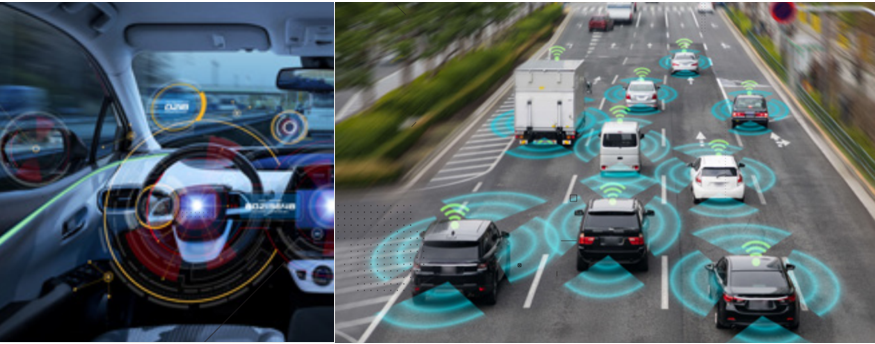
In developing solutions for automated driving, the Centre closely follows the academic field and the research advances made in the area, as well as staying in continuous close contact with clients to integrate consumer needs and demands.
“What we do is that we transfer our knowledge into the market and into the industry.”
Joshue Perez, Principal Researcher, TECNALIA
TECNALIA basically acts as an external R&D department for their clients. The clients cover a range of actors in the automotive ecosystem, such as manufacturers of vehicles, busses, trucks, and e-bikes, as well as logistics and freight companies. However, public road transport is the main client due to the magnitude of tenders and projects that characterise this domain both on national and European level. Hence, TECNALIA offers the know-how behind the automated vehicle – the technological architecture of AD – which is the underlying system that underpins the automation capability the clients’ vehicles. Commercialisation of the complete automated driving solution is handled by the client, and the TRL (Technological Readiness Level) strived for and achieved by TECNALIA is therefore relatively low.
“We are very ambitious in what we want do. But the TRL always needs to be raised once it goes to actual industry.”
Leonardo Gonzalez, Research Engineer, TECNALIA
The AD architecture is not yet deployed in vehicles that are commercialised and available on the market. However, the architecture is installed in a number of test vehicles by manufacturers who are testing the architecture in real world scenarios. TECNALIA cooperates with the clients on creating these simulated environments for real world scenarios testing. In these environments, the capability and flexibility of the solution are tested in relation to manoeuvring in emergency situations, different road structures, and complex environments.
TECNALIA’s AD architecture is based on a modular system called AUDRIC [1]. This system is installed in a vehicle where it manages transitions between normal operation and emergency situations in driving. Through integration of sensor signals, perception of the surroundings, and navigation, the system makes real-time decisions that enables automation of driving in shared traffic scenarios, such as urban environments.
AUDRIC follows an architecture that consists of six modules: acquisition, perception, communications, decision, control, and actuation.
These modules work together to easily integrate computing nodes and artificial intelligence (AI) into the vehicle, thereby enabling the automation capability.
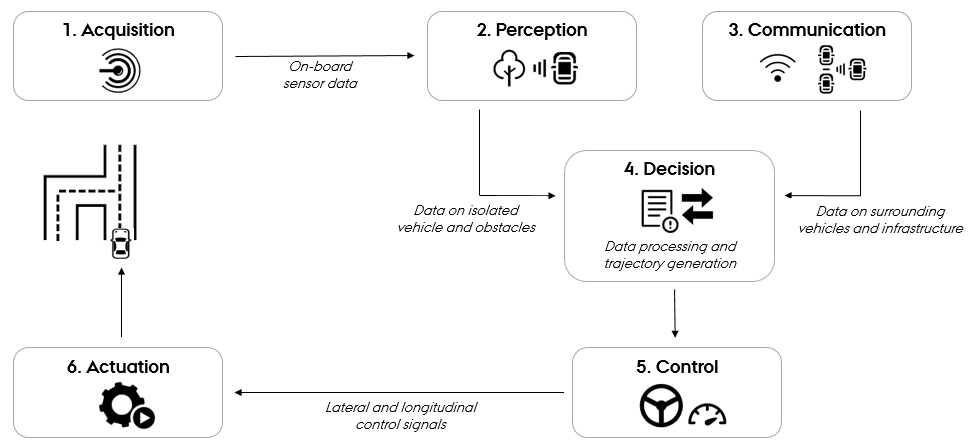
All the data that is collected, processed, and exchanged by the modular system constitutes the dynamic, sensorial, and kinematic knowledge of the vehicle. The essential capability – and challenge – of the system is to generate the real-time trajectory generations of the data that enable the timely activation of the decision, control, and actuation modules.
“The future path of automated driving goes through knowing the real time information around the vehicles.”
Joshue Perez, Principal Researcher, TECNALIA
AUDRIC represents a relatively standardized architecture that can easily be transferred from the system of one vehicle to another. This architecture provides the underlying system for a range of AD solutions and simulations. Towards total vehicle automation, TECNALIA has developed two types of solutions that leverage the system to encounter the forthcoming evolution of mobility: a system that assists driver decision-making, and a system that allows the driver to share control of the vehicle with its automated system. Both solutions lie at the core of the AD division’s specialised expertise on the decision and control modules.
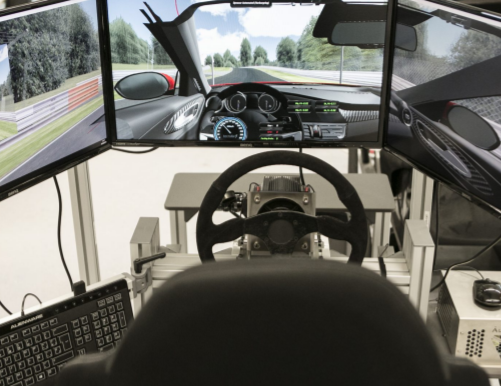
AD solutions exist with different levels of automation (LoA) ranging from 1 to 5 [2]. TECNALIA implements different vehicle automation degrees, from driving aid systems (at LoA 2), through shared control technologies, to fully autonomous vehicles (at LoA 5), with proprietary vehicle control technologies that integrate commercial and advanced solutions with sensors, cameras, and navigation.
Today, majority of vehicles rely on manual driving systems and a human driver to manage and coordinate the vehicles through traffic safely. Although TECNALIA and other actors develop AD systems that facilitate fully autonomous vehicles, the current status of commercialisation for automated driving is LoA 0, 1, and 2. Examples of such systems include lane departure warning at LoA 0, adaptive cruise control (ACC) at LoA 1, and lane-centring system with ACC at LoA 2.
The complexity of the technology sets high expectations to connectivity, capacity, and latency. There is a major discrepancy between the need for timely data exchange in AD solutions and general requirements for data protection.
“We have a real time problem. The information that we receive and handle, and how we process it, is critical at all times.”
Leonardo Gonzalez, Research Engineer, TECNALIA
In a functional AD solution, data needs to be exchanged and processed within milliseconds to make decisions and elicit timely actions. In traffic, these actions can be crucial in mitigating accidents, and just few milliseconds can be decisive for life or death. However, such apprehensive exchange of data cannot currently be achieved in a way that complies to the safety standards for data. A major challenge therefore exists in the readiness of the market in terms of insufficient capabilities of network infrastructure.
The evolution of AD solutions may be compared to the evolution of electric driving. For some time now, the electrification of cars has been subject for widespread attention due to the positive environmental impact it effectuates. This goes for both R&D being a prevalent initiative and the market being increasingly adopted by end-users and automotive manufacturers. However, still less than 5% of the cars that are currently driving on the Spanish roads are electric. The infrastructure is simply not ready yet, mainly due to scarce availability of charging points. Hence, a noticeable resemblance for these technologies lies in the curve of implementation and market readiness being significantly slower than the curve of development.
“The TRL of the system is very slow to be ready to the market.”
Joshue Perez, Principal Researcher, TECNALIA
Furthermore, the technological complexity of AD systems, and in particular for control and decision commands, causes the development in the area to progress slowly. The urgent matter of safety makes it a necessity for TECNALIA to thoroughly research and analyse all imaginable scenarios and manoeuvring possibilities. Having to consider the vast number of decisions we face when driving, as well as the amount of information we subconsciously rely on to make the correct decisions, accentuates the complexity of the driving process.
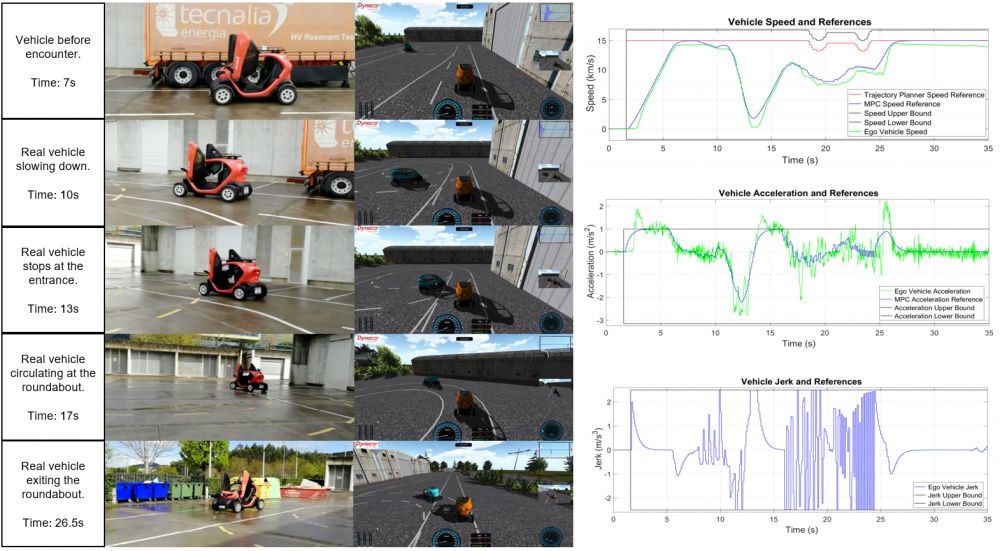
Urban scenarios remain one of the most challenging environments for automated driving functionalities given that vehicles must deal with a higher density of traffic, as well as additional agents, such as public transport, bicycles, and pedestrians. Recent studies show that vehicles need more complex decisions systems than aircraft due to the complexity of roadway interactions containing more signals, surroundings, and structures (i.e., roundabouts, intersections, lanes etc.) that challenge the sensing capabilities of the vehicle. To put this in perspective, a typical aircraft needs around 5 million lines of code to process the information needed for a functioning automated decision and control system. A typical commercial car will need around 100 million – equalling 20 times the processing capability of an aircraft.
“Before cars we used horses and horses defined the life of the people and the cities… Remember that cars changed everything? Now, automated driving is maybe the thing that will change the way we shape the cities.”
Joshue Perez, Principal Researcher, TECNALIA
This status quo reflects a technology under development for which relevant tests are being performed under controlled conditions. However, efforts are accelerating and interest is being shown by the research community and the market, motivating further developments and experimental tests in real vehicles, likely leading to full commercialisation in near future.
The research efforts and the AD architecture and solutions developed by TECNALIA are obvious contributions to the global ambition of transforming mobility and transportation towards an increasingly sustainable domain. AD solutions are forthcoming in improving road safety, and the system developed by TECNALIA leverage IoT to support vehicles of the future in delivering a driving experience that is smart, efficient, inclusive, and has low environmental impact.
“We are trying to translate to customers: We can do it, but it is not exactly cheap or ready – we are still developing.”
Joshue Perez, Principal Researcher, TECNALIA
Clients may anticipate TECNALIA to deliver a perfectly working solution at low operational costs and at a discounted price. However, due to the novelty of the AD technology and the available network infrastructure, such expectations are far from reality. Therefore, TECNALIA leaves commercialisation to the clients but cooperates closely with them during design, development, and integration to deliver individual solutions.
“When they [clients] start to make money, we say bye. Then we go find another way to create future business for the society.”
Joshue Perez, Principal Researcher, TECNALIA
TECNALIA is a non-profit privately driven research centre, implying that revenue streams are circular, and all generated profit is re-invested in further research activities. Income is generated primarily on intellectual property (IP) rights of the AD architecture, most often by selling the IP-licence to the client, giving the client permission to use some or all parts of a specific system or by integrating the IP architecture into the client’s business model and in turn receive a minor percentage of the client’s revenue.

The outcome of TECNALIA’s solution for the end-user, the driver, is the capability of the system to automate driving. This outcome leverages IoT to enable the six module architecture and thus the features it brings to the users.
“The delivery of the technology itself is our main focus. The automated driving capability is our main feature.”
Leonardo Gonzalez, Research Engineer, TECNALIA
Hence, the AD capability translates in a value proposition for the end users in terms of:
“We have this battle in the design of our controllers. Safety is main, but also comfort. …We discovered recently that they are not enemies. There may be coherence.”
Joshue Perez, Principal Researcher, TECNALIA
“One of the things that differentiate us from others is that we focus a lot on comfort and providing comfort in driving.”
Leonardo Gonzalez, Research Engineer, TECNALIA
“Our goal also is to improve traffic and reduce the timein going from point A to B in an efficient way.”
Joshue Perez, Principal Researcher, TECNALIA
The outcome of TECNALIA’s efforts on a visionary level is to improve, not only the driving experience for the individual user, but entire transport and mobility systems, as well as to facilitate the evolution towards sustainable mobility in urban and metropolitan environments.
Since TECNALIA decided to dedicate an entire division to conduct research in the area of AD solutions, a great amount of novel technological knowledge has been generated and transferred into the market. Many iterations have passed since the early system developments and the Centre has had many learnings along the way. Some of these learnings may have transmissible value for other actors in the IoT ecosystem.
“The solutions already available are not applicable for a future solution.”
Joshue Perez, Principal Researcher, TECNALIA
Despite the progress made in the AD domain, there is still a great amount of challenges and scenarios to be solved. Any good solution must have real time performance based on software and hardware module independence. All new knowledge leading towards this is progress and a step further towards intelligent transportation and mobility systems. TECNALIA finds purpose in being one of the actors at the forefront driving this progress.
TECNALIA considers a number of points to be vital for the forthcoming success of their AD solution. Taking departure in the current state of research and development carried out by the Centre, these points are compiled into a list of recommendations below:
1. Individualization is human-driven
TECNALIA believes that automated driving is the future of mobility, but stress that automation must never be at the expense of the driver – because the driver is the client.
“Humanity in the driving process is very important. So for us it is important to understand; how each driver is different, how each situation is different, how each condition is different.”
Joshue Perez, Principal Researcher, TECNALIA
The Centre recommends innovators to include clients in the design process of AD solutions. The human element, being the ability of the driver to interact with the automated decision and control system, must not be completely omitted. It represents a solitary opportunity to not only adapt the AD solutions to external settings, but also to individualise it to client preferences. Hence, not letting the automated system supersede the driver, but letting vehicle and human drive in synergy.
2. Standardization for integration
Exploiting standards that are available in the domain is essential for developing solutions that are applicable throughout the entire automotive ecosystem. The integrative ability of an AD system requires end-to-end consideration, explicating how it will move along the value chain, which actors will be involved in the process, and what elements are relevant where and to whom.
“We are working quite isolated. As integrators it is important to consider all parts of the elements in an IoT solution.”
Leonardo Gonzalez, Research Engineer, TECNALIA
Hence, to avoid solutions becoming too expensive and difficult for clients to incorporate into their business models and vehicles, TECNALIA recommends to build on top of the standards instead of inventing new technological systems bottom-up. Basically, 1) Research what are the current elements of this solution? 2) Research what can be improved and how? 2) Develop.
“Not only thinking about how IoT technologies can improve, but how they can be implemented.”
Joshue Perez, Principal Researcher, TECNALIA
3. Let specialization foster ecosystem collaboration
Historically, the automotive sector has progressed quite classically, but with the spread of digitalization, more components have been added to the value chain and more agents have enlarged the ecosystem.
“My advice to these companies is to make more collaboration and interaction with all the agents of IoT.”
Joshue Perez, Principal Researcher, TECNALIA
Likewise, actors that supply the software part of AD development act as specialists to support hardware suppliers, such as classical OEMs, helping them embrace the market’s quest for digitising the sector, and through collaboration develop the best solutions. Ultimately, the recommendation from TECNALIA is that one shall focus on doing what they are good at and outsource inferior undertakings to collaborate partners.
Research substantiates that once driverless cars become the norm, the flow of traffic and comfortability of driving will improve, while traffic jams, collisions, commute times, and gas usage will decrease – and of course – autonomous cars will reduce vehicular deaths and save people.
“We still have a long way to walk – or even run.”
Leonardo Gonzalez, Research Engineer, TECNALIA
Although the market is not yet ready, the AD technology development is constantly improving. This is a derived effect of an increasing demand both from the automotive sector and government, as well as cutting edge research efforts feeding the development. These improvements are what will drive the successful implementation and adoption of automated driving in the future.
“Automated driving will improve the traffic in the future. For this anticipation we need IoT technology.”
Joshue Perez, Principal Researcher, TECNALIA
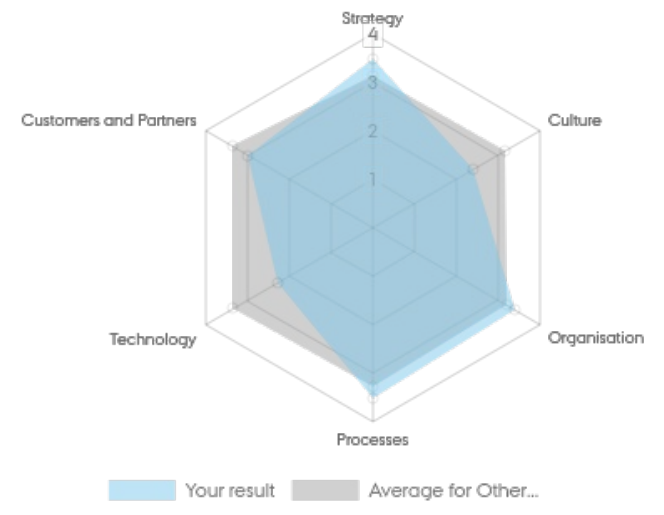
TECNALIA assumes a mediocre level of digital maturity with an overall score of 3.00. The score indicates that the digital capabilities of the company are vastly mature, and that they perform equally to average for the sector.
The Digital Maturity Assessment Tool is copyrighted by Associate Professor and PhD Annabeth Aagaard, Director at the Interdisciplinary Centre for Digital Business Development, Aarhus University. To get the digital maturity of your company mapped out, click here.
[1] Lattarulo, R., Pérez, J., & Dendaluce, M. (2017). A complete framework for developing and testing automated driving controllers. IFAC-PapersOnLine, 50(1), 258-263.
Hidalgo, C., Lattarulo, R., Pérez, J., & Asua, E. (2019, November). Hybrid trajectory planning approach for roundabout merging scenarios. In 2019 IEEE International Conference on Connected Vehicles and Expo (ICCVE) (pp. 1-6). IEEE.
[2] Levels of automation (LoA) defined by the Society of Automotive Engineers taxonomy.
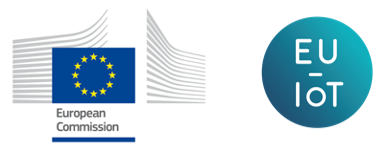
Copyright notice: © 2020 – 2023 EU-IoT Consortium.
This material was produced as part of the EU-IoT project, grant ID 956671, and is funded by the Horizon 2020 Framework Programme under topic ID ICT-56-2020.
EU-IoT is the European IoT Hub. The EU-IoT project works towards growing a sustainable and comprehensive ecosystem for Next Generation Internet of Things.
Source of origin: Information to document this use case originates from the H2020 call: SU-ICT-02-2020 Building blocks for resilience in evolving ICT systems (RIA); Project IoTAC 952684; Period: 01-09-2020 to 31-08-2023; EC contribution 5 mil. EUR.
